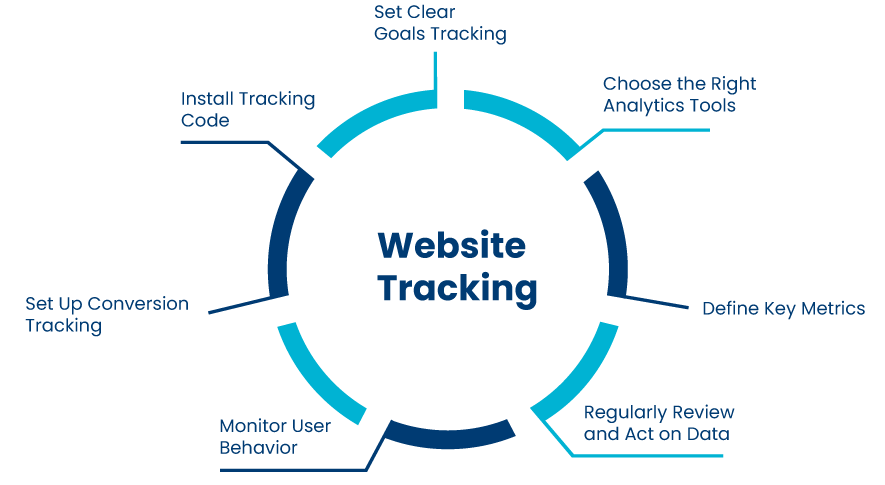Having a website is like having a storefront in the bustling marketplace of the internet. Just like a physical store owner would want to know how many people are walking in, what they’re looking at, and what ultimately convinces them to make a purchase, website owners need to understand how their online visitors behave. That’s where tracking website traffic, user behavior, and conversion metrics comes into play.
Imagine you have a website, and you’re curious about the people who visit it. You might be wondering, “How many people are coming to my website? What are they doing once they’re here? And most importantly, what can I do to make sure they take the actions I want them to?” Well, you’re in the right place because we’re about to break it all down for you.
Why Tracking Website Traffic Metrics Matters
Tracking website metrics is an indispensable aspect of managing and growing an online presence. It provides valuable insights that can inform strategic decisions, improve user experience, enhance ROI, and maintain a competitive edge. Let’s delve deeper into why tracking website metrics matters:
1. Data-Driven Decisions:
Without a clear understanding of how users interact with your website, you’re essentially operating in the dark. Tracking metrics empowers you to make decisions grounded in real data, rather than relying on guesswork or gut feelings.
This data-driven approach ensures that your efforts are aligned with actual user behavior, which can lead to more effective strategies. For instance, if you observe that a particular landing page has a high bounce rate, you can analyze why this is happening and make informed adjustments to improve its performance.
By continually monitoring metrics, you can refine your strategies over time, focusing on what works and discarding what doesn’t. This iterative process is key to staying competitive in the digital landscape.
2. Optimization:
Understanding user behavior is like having a roadmap to website improvement. Metrics allow you to identify areas where your website can be optimized to enhance the user experience, leading to increased engagement and conversions.
For example, if you discover that users frequently abandon their shopping carts on your e-commerce site, you can investigate the checkout process for friction points and streamline it to reduce drop-offs.
Metrics also help you spot which content resonates most with your audience. If certain blog posts or product pages consistently receive high traffic and engagement, you can create more of this type of content to meet your audience’s preferences.
3. Return on Investment (ROI):
Every business invests time and resources in marketing and website development. Tracking metrics allows you to measure the effectiveness of these investments.
By understanding which marketing channels drive the most traffic and conversions, you can allocate your resources more efficiently. If you discover that paid social media ads deliver a higher ROI compared to email marketing, you can adjust your budget accordingly.
ROI analysis also helps you justify your investments to stakeholders and make data-backed decisions about scaling or reallocating your marketing efforts.
4. Competitive Advantage:
Monitoring metrics keeps you informed about your performance but also helps you benchmark against competitors.
By analyzing your competitors’ metrics (where possible), you can identify areas where they excel and areas where they struggle. This competitive intelligence allows you to adapt your strategies and tactics accordingly.
Additionally, tracking metrics help you stay attuned to changing market trends. As user preferences evolve, your metrics can provide early signals, enabling you to adjust your approach proactively.
How to Take Advantage of Website Visitor Tracking in Your Operations
To effectively utilize website visitor tracking in your operations and improve your outreach, follow these steps:
Use Visitor Tracking Tools: Start by employing reliable visitor tracking tools. These platforms provide continuous data analysis, helping you identify trends and address inefficiencies promptly. Some popular tracking tools include Google Analytics, HubSpot, and Clearbit Reveal.
Understand Your Traffic: Gain a comprehensive understanding of your website traffic. Track where visitors are coming from, which pages they visit most, and which pages have high bounce rates. Combine this data with an Ideal Customer Profile (ICP) to better comprehend your prospects’ preferences and needs. Knowing who your website visitors are is crucial for tailoring your messaging and outreach strategies.
Identify High and Low-Performing Pages: Analyze the effectiveness of your website pages. If certain pages receive low traffic or have high bounce rates, it may indicate user experience (UX) issues. User experience is vital for website success, and tracking tools can help you pinpoint problems. Some tools even offer heatmaps to visualize visitor interactions. Use this data to improve underperforming pages and enhance the overall user experience.
Content Strategy Optimization: Use visitor tracking data to refine your content strategy. Examine the shared attributes of your most engaged visitors to identify what type of content and marketing initiatives resonate with your target audience. Adjust your content plans accordingly and modify strategies as needed to better engage prospects.
Getting Started with Website Tracking
To begin tracking website metrics, follow these steps:

1. Set Clear Goals:
Setting clear goals is the foundation of effective website tracking. Your objectives will dictate what metrics you should focus on and how you’ll measure success. Here are some common website goals:
Increasing Sales: If you’re running an e-commerce site, your primary goal might be to boost sales. Metrics like conversion rate, average order value, and revenue per visitor will be crucial.
Lead Generation: For a B2B website, generating leads might be your primary aim. Tracking form submissions, download rates for lead magnets, and the number of qualified leads generated is essential.
Content Engagement: If your website’s purpose is to provide valuable information, measure engagement metrics like page views, time spent on site, and the number of shares your content gets.
User Experience Improvement: Improving the user experience may be your main goal. Focus on metrics like bounce rate, session duration, and mobile responsiveness to gauge how well your site meets user needs.
2. Choose the Right Analytics Tools:
Selecting the appropriate analytics tool is a crucial step in understanding how your website is performing and how users are interacting with it. Here’s a simple guide on how to choose the right analytics tool for your needs:
Identify Your Needs: Begin by identifying your specific needs and goals. What do you want to track on your website? Is it visitor traffic, user behavior, or conversions? Your choice of tool should align with your objectives.
Consider Your Budget: Determine how much you’re willing to invest in analytics. Some tools are free, like Google Analytics, while others require a subscription. Evaluate your budget to find a tool that offers the features you need at a price you can afford.
User-Friendly Interface: Opt for a tool with a user-friendly interface, especially if you’re new to web analytics. Tools with intuitive dashboards and reporting can make the process smoother.
Compatibility: Ensure that the analytics tool you choose is compatible with your website platform (e.g., WordPress, Shopify) and other marketing tools you use (e.g., email marketing software).
Analytics Features: Look for features that suit your requirements. Some tools specialize in e-commerce tracking, while others excel at content analysis. Choose one that best fits your website’s focus.
Scalability: Consider the scalability of the tool. Will it accommodate your growing website and increasing traffic? You’ll want a tool that can evolve with your needs.
3. Install Tracking Code:
Installing the tracking code correctly is vital. Google Analytics provides a unique tracking code snippet for your website. You’ll need to place this code within the HTML of each page you want to track. This code collects data about user interactions on your site.
4. Define Key Metrics:
Understanding the metrics you’re tracking is crucial for interpreting your data effectively. Let’s break down these metrics:
Traffic Sources: Analyze where your traffic is coming from. It helps you allocate resources effectively. For instance, if most traffic comes from social media, invest more in social media marketing.
Page Views: Track which pages are the most popular. This information can guide your content strategy, helping you create more of what your audience enjoys.
Bounce Rate: A high bounce rate suggests that visitors are leaving your site quickly. Investigate pages with high bounce rates and improve their content or user experience.
Conversion Rate: The conversion rate tells you how effective your website is at turning visitors into customers or leads. Calculate it by dividing the number of conversions by the total number of visitors.
5. Set Up Conversion Tracking:
Setting up conversion tracking is a pivotal step in your journey to understanding how effectively your website meets its goals. Conversion tracking allows you to measure specific actions taken by your website visitors, whether it’s making a purchase, submitting a contact form, or signing up for a newsletter. Here’s how to do it:
Define Your Conversions: Start by clearly defining what constitutes a conversion for your website. Is it a completed purchase, a filled-out form, or some other action? Knowing this is crucial.
Utilize Tools: Most analytics platforms, like Google Analytics, offer built-in features for setting up conversion tracking. Identify the goals or events you want to track and configure your analytics tool accordingly.
Implement Tracking Codes: Similar to how you added the tracking code in the initial setup, you’ll need to insert tracking codes or tags into the specific pages or actions you want to track as conversions. These codes send data to your analytics tool when a user completes the desired action.
Test and Verify: After implementing tracking, test it thoroughly to ensure it’s working as intended. Complete the conversion actions yourself and check if the data registers correctly in your analytics reports.
6. Monitor User Behavior:
Understanding how users behave on your website is like having a window into their preferences and interests. Monitoring user behavior helps you make informed decisions about how to improve their experience. Here’s what you need to do:
Analyze User Flow: Study the paths users take through your website. Are they finding what they’re looking for easily, or are they dropping off at certain points? Tools like Google Analytics’ User Flow feature can provide visual insights.
Examine Site Speed: A slow website can frustrate visitors. Regularly check the loading times of your pages, especially on mobile devices. Faster-loading pages tend to have lower bounce rates and higher engagement.
Device and Browser Usage: Determine which devices and browsers your visitors use most frequently. This information helps you prioritize your site’s compatibility and optimization efforts.
Identify Trends: Keep an eye on trends in user behavior. Are there seasonal fluctuations or changes in how visitors access your site? Understanding these patterns can guide your content and marketing strategies.
7. Regularly Review and Act on Data:
Your website’s analytics data is a treasure trove of insights, but it’s only valuable if you act on it. Regularly reviewing and acting on data ensures that your website remains dynamic and responsive to your audience’s needs. Here’s how to approach it:
Schedule Regular Check-Ins: Set up a routine to review your analytics data. This could be weekly, monthly, or quarterly, depending on your website’s activity.
Identify Trends and Patterns: Look for trends, anomalies, and patterns in the data. Are there pages with declining traffic? Is there a sudden surge in conversions? These observations provide opportunities for action.
Set Goals for Improvement: Based on your data analysis, set clear, actionable goals for improving your website. Whether it’s optimizing content, redesigning a page, or refining your marketing strategy, having goals in place keeps your efforts focused.
Implement Changes: Take action to address the insights you’ve gained. Make the necessary adjustments to your website, content, or marketing campaigns. Be sure to track the impact of these changes to measure their effectiveness.
Additional Tools and Tips
While Google Analytics is a great starting point, consider these additional tools and tips to enhance your tracking efforts:

Heatmaps:
What it is: Heatmaps are visual representations of user interaction with your website. They show where users click, move their mouse, or scroll.
Why it’s valuable: Heatmaps help you understand how users engage with your content, which can be invaluable for optimizing page layouts and identifying areas of improvement.
Tools to use: Popular heatmap tools include Hotjar, Crazy Egg, and Clicktale.
A/B Testing:
What it is: A/B testing, also known as split testing, involves creating multiple versions of web pages, ads, or email campaigns to determine which performs better in terms of conversion rates.
Why it’s valuable: A/B testing allows you to make data-driven decisions by comparing the effectiveness of different elements and strategies.
Tools to use: Consider using tools like Optimizely, Google Optimize, or even built-in A/B testing features offered by email marketing platforms.
Email Tracking:
What it is: Email tracking tools monitor various metrics for your email campaigns, including open rates, click-through rates, and conversion rates.
Why it’s valuable: Email tracking helps you gauge the effectiveness of your email marketing efforts and refine your email content and strategies accordingly.
Tools to use: Email marketing platforms like MailChimp, Constant Contact, or HubSpot often offer email tracking features. You can also use standalone tools like Mailgun or SendGrid for advanced tracking.
SEO Tools:
What it is: SEO (Search Engine Optimization) tools help you monitor your website’s search engine rankings, organic traffic, and keyword performance.
Why it’s valuable: SEO is critical for driving organic traffic to your site. These tools provide insights and recommendations to improve your website’s visibility in search results.
Tools to use: Consider using SEO tools like Moz, SEMrush, Ahrefs, or even Google Search Console for monitoring and optimizing your website’s SEO performance.
Social Media Analytics:
What it is: Most social media platforms offer analytics tools that provide insights into post engagement, audience demographics, and more.
Why it’s valuable: Social media analytics help you refine your social media strategy by understanding what content resonates with your audience.
Tools to use: Utilize the built-in analytics provided by platforms like Facebook Insights, Twitter Analytics, and Instagram Insights.
Mobile Analytics:
What it is: Mobile analytics focus on metrics specific to mobile users, such as mobile bounce rate and page load times.
Why it’s valuable: With the increasing use of mobile devices, optimizing the mobile experience is crucial. Mobile analytics provide insights into user behavior on mobile devices.
Tools to use: Google Analytics offers mobile-specific reports, and you can also use mobile app analytics tools like Firebase or Flurry for mobile app tracking.
Customer Feedback:
What it is: Gathering feedback from website visitors through surveys, live chat, or feedback forms to gather qualitative data.
Why it’s valuable: Customer feedback provides insights into user preferences, pain points, and areas for improvement that quantitative analytics may not capture.
Tools to use: Tools like SurveyMonkey, Qualtrics, or even on-site chat platforms like Intercom or Drift can help you collect and analyze customer feedback.
Conclusion
Tracking website traffic, user behavior, and conversion metrics is essential for any online venture. It empowers you to make data-driven decisions, optimize your website, and improve your online presence. While it may seem overwhelming at first, start with the basics, and gradually explore more advanced tools and techniques as you become more comfortable with website tracking. Remember, the key is to act on the insights gained from your data to continuously improve your online performance and achieve your business goals.









